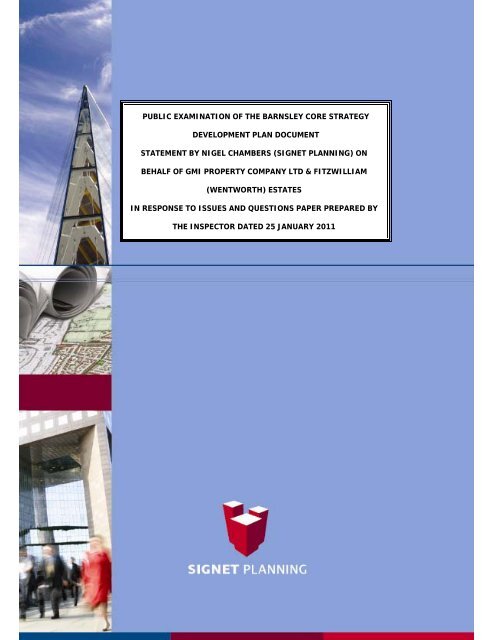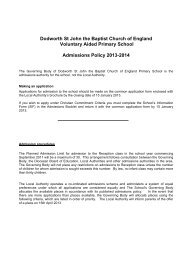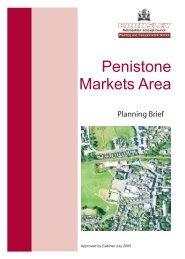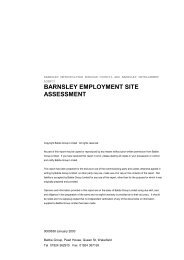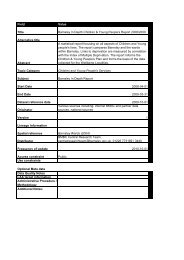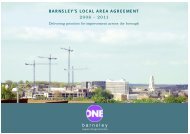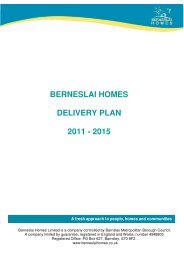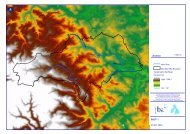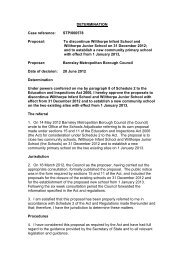signet planning - Barnsley Council Online
signet planning - Barnsley Council Online
signet planning - Barnsley Council Online
- No tags were found...
You also want an ePaper? Increase the reach of your titles
YUMPU automatically turns print PDFs into web optimized ePapers that Google loves.
PUBLIC EXAMINATION OF THE BARNSLEY CORE STRATEGYDEVELOPMENT PLAN DOCUMENTSTATEMENT BY NIGEL CHAMBERS (SIGNET PLANNING) ONBEHALF OF GMI PROPERTY COMPANY LTD & FITZWILLIAM(WENTWORTH) ESTATESIN RESPONSE TO ISSUES AND QUESTIONS PAPER PREPARED BYTHE INSPECTOR DATED 25 JANUARY 2011
GMI Property Company ID No. 425207Representation Nos. 444-453Fitzwilliam (Wentworth) Estates ID No. 22403Representation Nos. 403-431PUBLIC EXAMINATION OF THE BARNSLEY CORE STRATEGYDEVELOPMENT PLAN DOCUMENTSTATEMENT BY NIGEL CHAMBERS (SIGNET PLANNING) ONBEHALF OF GMI PROPERTY COMPANY LTD & FITZWILLIAM(WENTWORTH) ESTATESIN RESPONSE TO ISSUES AND QUESTIONS PAPER PREPARED BYTHE INSPECTOR DATED 25 JANUARY 2011SIGNET PLANNINGThe HamletHornbeam ParkHarrogateHG2 8RETelephone: 01423 878550Facsimile: 01423 815599www.<strong>signet</strong><strong>planning</strong>.comSignet Ref:HG1448Date: 18 February 2011COPYRIGHTThe contents of this document must not be copied orreproduced in whole or in part without the written consentof Signet Planning
CONTENTSPage NoSECTION 1: INTRODUCTION 1SECTION 2: THE CORE STRATEGY AS A WHOLE 2SECTION 3: LOCATION OF GROWTH 4SECTION 4: HOUSING 7SECTION 5: ECONOMY AND EMPLOYMENT 9SECTION 6: TRANSPORT 12SECTION 7: GREEN BELT 13SECTION 8: TOWN CENTRES 15SECTION 9: INFRASTRUCTURE 16SECTION 10: CONCLUSIONS 17APPENDICES:APPENDIX A:CLUSTER SETTLEMENTS – A DEFINITIONAPPENDIX B: ADOPTED TABLE 2 FROM BARNSLEY CORE STRATEGY –BACKGROUND PAPER 3 HOUSING
SECTION 1:INTRODUCTION1.1 Signet Planning has been appointed to act for both GMI Property Company Ltd andFitzwilliam (Wentworth) Estates in regard to the promotion of their interests withinthe <strong>Barnsley</strong> area.1.2 Both clients control significant land interests within the authority’s boundaries whichcould make a significant contribution to growth, development and regeneration of<strong>Barnsley</strong> as part of achieving the key spatial objectives of the Core Strategy. Theseinclude:i) A substantial site adjoining Junction 36 of the M1 motorway which waspreviously identified as a potential strategic business park in the emergingUDP during the 1990s.ii) A substantial area of land under their control within the Dearne Valley closeto the Principle Town of Goldthorpe.iii) A substantial area of safeguarded land directly north of Hoyland.iv) The site of the former Elsecar Colliery, Elsecar.Page 1
SECTION 2:THE CORE STRATEGY AS A WHOLEG5 & G6G5.1 The CS lacks vision and is not ambitious enough as a tool to promote theregeneration of the borough. The employment targets in particular seek only tobenchmark the town with other boroughs. We have suggested that a targetemployment rate of 80% should be pursued with an additional 5,000 jobs over andabove the CS target.G13G13.1 The CS relies upon an unsound and incomplete evidence base and does not providea robust basis upon which to plan. Several key studies have been completed sincepublication of the CS, for example, the Employment Land Review, Smaller RetailCentres Study and the Infrastructure Study. Moreover, the Northern <strong>Barnsley</strong>Connectivity Study has not yet been completed and neither has the Local EconomicAssessment. In addition, we are of the view that the SHLAA is a substantially flaweddocument. We shall return to the specific inadequacies of the evidence base and thestudies and reports undertaken throughout this statement.G13.2 Bearing in mind the incomplete evidence base at the point of publication of the CSwe argue that plan-making took place in a relative vacuum and did not inform theprocess. This is contrary to the advice within PPS12, rendering the CS unsound. Onecould suggest that the <strong>Council</strong> prepared the CS to suit its own agenda, rather thanusing the evidence base to help steer its approach.G15G15.1 We suggest that the CS does not meet the test of soundness as required by PPS12,particularly its failure to consider a range of alternative strategic developmentoptions. In summary, it is clear that the CS has never properly considered any of thefollowing strategic development options:• A review of the Green Belt to accommodate housing needs;• Sustainable urban/settlement extensions;Page 2
• Key/premium Business Park allocations to drive employment growth;• Clustered settlements as a focus for growth.G15.2 Consequently, the preferred strategic option proposed cannot be considered to bethe best from a suitable range of alternatives. Indeed, it is our belief that a strategywhich incorporates the components identified above would be demonstrably betterthan the option pursued with the CSPage 3
SECTION 3:LOCATION OF GROWTHS2S2.1 Urban <strong>Barnsley</strong> is not appropriately defined in the CS. In the <strong>Council</strong>’s ExaminationBackground Papers there is a failure to develop a reasoned argument why theboundaries agreed under the UDP need to change. It is clear that the CS proposes toenlarge Urban <strong>Barnsley</strong> to include Dodworth and Darton in order that it can attemptto accommodate substantial housing growth without reviewing Green Beltboundaries.S2.2 We would argue that this is not a sustainable option. The opportunity should betaken to review Green Belt boundaries in order to accommodate sustainable urbanextensions comprising housing and employment within a mixed use comprehensivelyplanned development. The alternative option being pursued by the CS will result in amore dispersed pattern of development contrary to the aims of the RSS and wouldfail to secure the benefits of urban extension proposals which we outlined in ourprevious submission.S2.3 We believe that the settlement hierarchy being considered is not appropriate. The<strong>Council</strong> acknowledge themselves that there are a high number of Principal Towns(PT) identified in the RSS (BMBC Background Paper 1; 6.3). Accordingly, in order toact as a focus for development, growth and regeneration we have argued that aClustered Settlement (See Appendix A) approach should have been taken by the CS.S2.4 The CS has already taken the advice of Jacobs by “clustering” the Dearne Towns ofGoldthorpe, Bolton upon Dearne and Thurnscoe and focusing growth on Goldthorpe.An argument could also be made that the CS is attempting to undertake this processby “clustering” Darton and Dodworth with <strong>Barnsley</strong> (although in this case it is ourbelief that this will have the opposite effect by dispersing growth). In this respect,our view is that the key reason for the clustering is not to ensure a strong focus ofgrowth on <strong>Barnsley</strong> but an attempt to remove pressure on the town’s Green Belt toaccommodate housing use.Page 4
S2.5 We have set out before that a number of identified “Clustered Settlements” shouldform the basis of the settlement hierarchy, based upon the PTs of Goldthorpe,Cudworth, Hoyland/Wombwell and Penistone. Each settlement should be the focusfor employment and retail development and the most significant residential growth.<strong>Barnsley</strong> needs to attract and focus what growth and investment it can to thesesettlements as the best way to regenerate its economy. The alternative beingpursued by the CS adds to the list of growth foci, replicates the status quo of thehistoric mining settlements and will result in growth being spread too thinly to be ofsignificant benefit.S4S4.1 Royston should not be identified as a PT. We have set out above why, in general,growth and development should be focused on Clustered Settlements. Adding to thelist of PTs will dissipate growth not focus it. Within its Examination BackgroundPapers we find no convincing argument by the <strong>Council</strong> for the inclusion of Royston asa PT. Moreover, the infrastructure is not there to support its elevation.S4.2 The England & Lyle Smaller Retail Centres study attempts to lend support to theelevation of Royston to PT status. It argues that it is one of the few town centreswhich has the capacity to expand. We do not accept this. Indeed, Cudworth towncentre has potential sites within its defined boundary in which to expand. Moreover,it has substantial opportunities for expansion directly adjoining its defined centrewhich, we argue, is more sustainable than the expansion of a centre which is not yeta PT.S4.3 Proposals to elevate Royston to PT status appear to be an attempt to maintain thestatus quo of the historic mining village settlement pattern. The CS should be aforward not backward looking plan which tries to generate and define appropriateroles for settlements.Page 5
S5S5.1 We do not believe that the CS sets out an appropriate balance between <strong>Barnsley</strong>,PTs and other settlements and we have set out previously alternatives. In particular,our argument that Dodworth and Darton be excluded from Urban <strong>Barnsley</strong> has led tosuggestions that a smaller housing target is pursued for <strong>Barnsley</strong> and a largerquantum for other settlements. We argue that this is a more flexible approach whichdoes not undermine the goals of the CS.Page 6
SECTION 4:HOUSINGH4H4.1 The SHLAA does not demonstrate that housing growth can be accommodatedwithout the need to review the Green Belt. In particular, the abolition of minimumdensity requirements, together with a move away from apartments, townhouses andincreased demand for family housing and gardens has not been reflected in theSHLAA work. Evidence would seem to indicate that housing densities are likely todecrease over the coming years.H4.2 The CS is based upon a challenging average density of 40 dph. In order to be robustwe would argue that the SHLAA needs to be tested at density levels of 30-35 dph.Accordingly, Appendix B adapts Table 2 of the <strong>Council</strong>’s Background Paper onHousing to stress test the SHLAA at densities of 35 and 30 dph.H4.3 The table in Appendix B demonstrates that, with the exception of Cudworth andWombwell, the SHLAA cannot accommodate the CS housing numbers even if thedensity level is set at 35 dph.H6H6.1 The CS is not an effective basis upon which to distribute housing growth, does not,in our view, reflect the roles/character of the settlements and is inferior to otheralternative spatial strategies; particularly one which promotes sustainableurban/settlement extensions, a review of Green Belt boundaries and a ClusteredSettlement approach (see C 1.2).H6.2 We suggest that the CS would be substantially improved by incorporating theconcepts highlighted above. Moreover, it would be better placed to provide spatialguidance on the overall location of housing development and give much improvedstrategic direction for the Development Sites & Places DPD.Page 7
H9H9.1 We argue the SHLAA process demonstrates that insufficient suitable, deliverable andavailable sites are identified to accommodate the growth figures pursued within theCS. We refer to Appendix B which highlights the fragility of the CS on this basis.H9.2 There is no guidance on settlements below PT status. However, we argue that theglobal numbers are inadequate for the number/scale of villages and their needs. Ahigher number would offer flexibility and scope for sustainable development withoutundermining the CS itself. We did suggest suitable figures within our originalsubmission.Page 8
SECTION 5:ECONOMY AND EMPLOYMENTEE1 & EE3EE1.1 We are of the view that the economic transformation desired by the <strong>Council</strong> is notmet by the CS. It lacks the necessary vision and imagination which we argue isrequired if the <strong>Council</strong> is serious in its desire to create and attract new sources ofprivate sector employment.EE1.2 Whilst the <strong>Council</strong> acknowledge that public sector job losses need to be replaced bythe private sector the CS offers limited scope to offset such losses. Since publicationof the CS more evidence is available highlighting towns/regions of the UK mostsusceptible to public sector job reductions. For example, the State of the Nationreport by the CEBR, outlines problems for several regions, including Yorkshire & TheHumber, reliant upon public sector jobs.EE5EE5.1 The Employment Land Review acknowledges that there is a requirement for 500Haof employment land within the CS period. This is based upon established Brown Bookstandards. Reducing the employment land requirement by 150 Ha is demonstrationthat the CS lacks vision and ambition in a period of public sector job losses.EE5.2 The CS suggests that Green Belt boundaries will be reviewed to accommodateemployment land allocations, if required. It also acknowledges that in the latterstages of the CS the Local Economic Assessment for <strong>Barnsley</strong> could act as a triggerto allocate additional employment land. It cannot be considered appropriate toreview Green Belt boundaries within an adopted plan period to allocate employmentland that is known to be required at the plan’s outset. Instead, it should be policy toallocate the employment land required at the outset, rather than on an incrementaland piecemeal basis.Page 9
EE7.2 The policy is also poorly aligned with proposed housing allocations. For example, inour original submission, we argued that the Dearne Valley/Goldthorpe settlementcluster, identified as a sub-regional priority in the RSS and a key focus of growth inthe Sheffield City Region, has a very low proposed employment land allocation. Thisnot only fails to meet the established vision/ambition for the Dearne Valley but itdoes not match with proposed housing growth numbers in the CS; the highestoutside of Urban <strong>Barnsley</strong>. This approach is not sustainable.EE7.3 Within the CS area between 3-5 key/premium business park sites could beaccommodated at high profile, gateway locations. To be effective each needs to beat least 40Ha in size in order to offer the scale, quality and mixed use plannedenvironment which is attractive to a wide and diverse range of potential privatesector employers. Such locations need to be accessible to the M1 and Dearne ValleyParkway.EE7.4 The proposal outlined above is also compatible with sustainable urban extensions,clustered settlements and a review of the Green Belt. It offers a better strategy foremployment generation and employment land allocation than that advanced underthe CS.EE8 & EE9EE8.1 Policy CSP12 does not offer sound spatial guidance for future employment landallocations. The alternative vision we advance in EE7 above offers much clearerspatial guidance which is more effective in attracting potential employers. Moreover,it offers the opportunity to plan in a sustainable manner by incorporating housingdevelopment as part of a mixed use urban settlement extension.Page 11
SECTION 6:TRANSPORTT1T1.1 We are concerned that the CS is significantly weakened bearing in mind that theNorthern <strong>Barnsley</strong> Connectivity Study has not been completed. Indeed we agree withthe Inspector in his observation that the study is central to the spatial strategy; atleast in respect of Urban <strong>Barnsley</strong>.T1.2 We have suggested in previous submissions that the “Northern Orbital Route” iscarried forward in the CS from the adopted UDP. We are pleased to note that theDeloitte “<strong>Barnsley</strong> Infrastructure Study”, commissioned by BMBC, recognizes theimportance of this road link to potential employment allocations. We would like tosee this go further to acknowledge its importance to housing allocations andsustainable urban/settlement extensions.T5T5.1 We agree that Policy CSP 24 should be more proactive in committing to the reopeningof disused railway lines and new stations at Cudworth and the DearneValley. We remain disappointed that further study work on the re-opening of the raillines and potential stations has not been commissioned and further illustrates thelack of ambition of the CS.Page 12
SECTION 7:GREEN BELTGB1GB1.1 We remain strongly of the view that the CS remains weak unless it undertakes areview of the Green Belt in order to determine and explore the opportunity toaccommodate future housing growth. We have suggested at H9 and in Appendix Bthat the <strong>Council</strong>’s SHLAA is flawed and underestimates the quantum of housing landrequired. In conclusion, our view is that the housing growth requirement is unlikelyto be met without a review of the existing Green Belt boundary.GB1.2 We would argue that a full review of safeguarded land and the Green Belt should beundertaken to identify the most sustainable options for both housing andemployment growth. Moreover, the opportunity should have been taken to considersustainable urban/settlement extensions (see C 1.2) as part of this review process.GB1.3 Consequently the CS suffers from a rigid approach where the policy of no Green Beltreview has been placed at the forefront of defining the overall spatial strategy. In ourview, this has resulted in severe compromises being taken; dispersing developmentoutside of the adopted Urban <strong>Barnsley</strong> area, failure to fully consider the co-locationof housing and employment allocations and the potential “pepper potting” of housingland allocations which avoid Green Belt development. This latter point, in particular,is likely to mean that the advantages of a Master Planned urban extension are notavailable in the form of social, economic and community infrastructure.GB2GB2.1 It is unlikely that the identification of current safeguarded land for housing use wouldobviate the need to review the Green Belt to accommodate such growth. Much of thesafeguarded land cannot be developed or is not well located to promote sustainabledevelopment. A full scale review is needed as set out in GB1.2 above.Page 13
GB3GB3.1 We too are puzzled by a “localised review” which appears to be at odds with“strategic development sites”. We remain of the view that a full and comprehensivereview of the Green Belt is required for both housing and employment landallocations.Page 14
SECTION 8:TOWN CENTRESTC1TC1.1 Since publication of the CS the <strong>Council</strong> has commissioned the Smaller Retail Centresstudy by England & Lyle. This attempts to provide guidance on retail capacity withineach PT and their potential for expansion. We suggest that this study fails in thisattempt.TC1.2 The study is backward looking. In regard to convenience goods, for example, itsuggests that current retention rates for Hoyland and Cudworth will remain thesame. However, where plans or recently completed schemes have been undertakenthe retention rates have been substantially increased. In Penistone, where Tesco hasrecently opened, the retention rate is forecast to increase from 14 to 50%. Similarly,in Goldthorpe, where the Town Centre Master Plan proposes a new foodstore, theretention rate is forecast to increase from 15 to 40%.TC1.3 Had the consultants chosen to forecast increases to between 40-50% in other PTs,for example Hoyland or Cudworth, then capacity for an additional foodstore is likelyto have been demonstrated.TC1.4 We have also criticized the study in S4.2 in respect of Royston where we argue thatseveral PTs are able accommodate the sustainable expansion of foodstore facilities incontrast to the position taken in the study.Page 15
SECTION 9:INFRASTRUCTUREI1I1.1 We remain concerned that the CS is undermined by failing to complete the <strong>Barnsley</strong>Northern Connectivity study which is central to the achievement of the growthagenda in Urban <strong>Barnsley</strong>. More particularly, completion of the <strong>Barnsley</strong> NorthernOrbital is fundamental to the future of the town and should be carried forward as acommitment from the adopted UDP.I1.2 The opportunity of seeking to procure the provision of infrastructure by public andprivate sector means does not feature as a high priority within the CS. In a period ofsignificantly reduced public expenditure this approach is mistaken. As the Deloitte“<strong>Barnsley</strong> Infrastructure Study” itself acknowledges at P70:“.. the <strong>Council</strong> will need to be more creative in delivering infrastructureand will need to adopt a pivotal role in engaging with the wider public andprivate sector to deliver infrastructure as part of its Place Makingresponsibilities.”I1.3 The CS must move away from a traditional reliance on the public sector to providethe <strong>Barnsley</strong> Orbital Route, the re-opening of the Cudworth and the <strong>Barnsley</strong>-Doncaster rail lines and proposed new stations. As the Deloitte study recommends,the case is made for a more creative and collaborative approach to infrastructureprovision. The study also suggests that it will be necessary to complete majorinfrastructure schemes in order to unlock potential development sites. We suggestthat this is particularly relevant in the context of the proposed schemes identifiedabove.Page 16
Appendix AClustered Settlements – A DefinitionOutside of the main urban <strong>Barnsley</strong> area the settlement pattern is dominated by a numberof historic mining villages. We agree with the CS that they have, traditionally, been selfcontained communities based upon the local mine with transport connections focused upon<strong>Barnsley</strong> town centre, rather than with each other.It is difficult to generate and define appropriate roles for these old mining villages now thatmining is no longer relevant. The <strong>Council</strong> and the RSS have both attempted to undertakethis task. It is generally acknowledged that, due to the mining legacy, there are a relativelyhigh number of PTs identified within the RSS.Geographically, distances between several mining villages are not that great and, it is ourview, that this is one of the key reasons for the suggestion that the concept of clustering isappropriate in order to provide a better focus for growth and development.Secondly, the Dearne Towns Link Road has made great strides to improve connectivitybetween several villages. Construction of the <strong>Barnsley</strong> Northern Orbital will complete a linkroad between most of the old mining villages. Finally, the re-opening of the Cudworth and<strong>Barnsley</strong>-Doncaster railway lines, together with new stations, should complete most of thehard infrastructure connecting an arc of settlements from Hoyland in the south to Darton inthe north.We argue that the CS needs to acknowledge firstly that there are too many PTs to be aneffective focus for development moving forward. Secondly, an attempt to increase thenumber by elevating Royston to PT can only exacerbate this problem.By clustering a number of settlements which are close together geographically and can takeadvantage of recently improved and future potential infrastructure connections is a conceptwe believe to be an appropriate route for the CS to follow. In this respect, a key settlementis identified as the primary focus for growth (particularly for employment and as aretail/town centre destination) for a range of surrounding villages in relatively closeproximity.
This approach to growth and development has already been undertaken in the DearneValley with Goldthorpe already identified as the key settlement. The town is also proposedto accommodate the bulk of the employment land allocations in the area and, via an agreedtown centre Master Plan, the main retail and service centre for both Thurnscoe and Boltonupon-Dearne.
Appendix BAdapted from Table 2, (P7) <strong>Barnsley</strong> Core Strategy – Background Paper 3 HousingSettlement(i)(ii)(iii)(iv)2008 - 2026 Core Strategy At 35 dph Surplus/Deficit At 30 dph Surplus/DeficitUrban <strong>Barnsley</strong> 10,863 9,800 9,505 (293) 8,147 (1,653)Cudworth 2,497 1,800 2,184 384 1,827 72Goldthorpe 3,178 3,000 2,780 (220) 2,383 (617)Hoyland 1,850 1,800 1,618 (182) 1,387 (413)Penistone 1,071 1,100 937 (163) 803 (297)Royston 1,099 1,000 961 (39) 824 (176)Wombwell 2,979 2,000 2,606 606 2,234 234Other 868 1,000 759 (241) 651 (349)(i) Figures taken from BMBC Table 2 – based upon 40 dph(ii) Figures taken from BMBC Table 2(iii) Figures from column (i) and applied at a rate of 35 dph(iv) Figures from column (i) and applied at a rate of 30 dph


